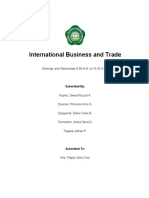Unusual Asian Delicacies: Buko Pandan
Unusual Asian Delicacies: Buko Pandan
Uploaded by
Xyries Blues IlagaCopyright:
Available Formats
Unusual Asian Delicacies: Buko Pandan
Unusual Asian Delicacies: Buko Pandan
Uploaded by
Xyries Blues IlagaOriginal Description:
Original Title
Copyright
Available Formats
Share this document
Did you find this document useful?
Is this content inappropriate?
Copyright:
Available Formats
Unusual Asian Delicacies: Buko Pandan
Unusual Asian Delicacies: Buko Pandan
Uploaded by
Xyries Blues IlagaCopyright:
Available Formats
BUKO PANDAN: it is a favorite Filipino salad served in almost every kind of
party and special occasions in the Philippines. It is made using young coconut and
buko pandan flavor and aroma.
At first glance, this sumptuous dessert can be mistaken for Buko Salad because of
the similarity in texture and dairy ingredients used. However, the green gelatin
and green nata de coco which contains the aroma and flavor of the Pandan gives
the distinction.
http://www.pinoychow.com/buko-pandan/
Sinigang is a Filipino soup or stew characterized by its sour and savoury taste most often associated
with tamarind (Filipino: sampalok). It is one of the more popular viands in Philippine cuisine, and is related to
the Malaysian dishsinggang.
Sinigang is traditionally tamarind-based. Variations of the dish derive their sourness from ingredients such
as guava, calamansi, bilimbi(balimbng), or unripe mango.[1]Seasoning powder or bouillon cubeswith a tamarind
base are commercial alternatives to using natural fruits.
The Souring Agents of Sinigang
Where to find: Phillipines
Native to Phillipines, Baluts are half-fertilized duck or chicken eggs boiled with its shell. It doesnt exactly look inviting as the semideveloped ducklings are already visibly formed. However, the Balut is a popular local dish eaten throughout the Phillipines, believed to
be an aphrodisiac and considered a high-protein, hearty snack. Often served with beer, the biggest challenge in trying out balut is
overcoming its unappetizing sight, but most people would agree that it tasted much better than it looks.
Unusual Asian Delicacies
The most popular term dinuguan and other regional naming variants come from their respective word for "blood"
(e.g. "dugo" in Tagalog means "blood" hence "dinuguan" as "to be stewed with blood"). Possible English translations
include pork blood stew or blood pudding stew.[2]
It is frequently considered an unusual or alarming dish to foreigners though it is rather similar to Europeanstyle blood sausage, or British black pudding in a saucy stew form.[3] It is perhaps closer in appearance and
preparation to the Polish soup Czernina or an even more ancient Spartan dish known asmelas zomos (black soup)
whose primary ingredients were pork, vinegar and blood.
Filipino Delicacies
\
http://panlasangpinoy.com/
Kare Kare is a traditional Filipino stew complimented with a thick savory peanut sauce. The commonly used meats
for this dish are ox tail, tripe, and pork leg; on some occasions goat and chicken meat are also used. Besides the
peanuts, this dish depends on the shrimp paste (on the side) in order to be fully enjoyed. Traditionally, palayok
(clay cooking pot) is used to cook this dish and it is also used as the serving pot.
I almost tried every meat that can possibly used in cooking Kare-Kare and in my opinion ox tail, pigs leg, cows face
(yes, face off), and tripe are the ones that I like. Ask every Filipino that you know and Im sure that they have a lot to
say about this wonderful dish.
Leche Flan (also known as crme caramel and caramel custard) is a dessert made-up of eggs and milk with a soft
caramel on top. This dessert is known throughout the world (especially in Europe) and has been in the dessert
menu of most restaurants because of its convenience in preparation and long shelf life.
In the Philippines, Leche Flan is the top dessert of all time. During celebrations such as parties and town fiestas, the
dining table wont be complete without it.I remember the Leche Flan that my Lola Belen makes when I was still living
in Las Pinas. It really tasted so rich and heavenly; everyone in our family always requests her to make leche flan
during special occasions. As for me, Im still lucky because my wife knows how to make a good one too (this is
actually her recipe). If I did it my way (not the songplease), you might be having Leche Flan that tastes like Egg
Pie instead.
Lumpiang Shanghai or Spring Rolls is a dish made-up of ground pork or beef, minced onion, carrots, and spices
with the mixture held together by beaten egg. It is of Chinese origin (originally called lunpia) and was brought to the
Philippines by Chinese immigrants from the Fujian province.
In the Philippines, Lumpiang Shanghai is a common menu during celebrations and feasts (just like the Pancit
Bihon). It is best if combined with sweet and sour sauce but on some occasions Banana ketchup is preferred.
You might also like
- Filipino CuisinesDocument14 pagesFilipino CuisinesDonsNo ratings yet
- Philippine CuisineDocument40 pagesPhilippine CuisineEvonee Kate AgustinNo ratings yet
- Lecture 10A - Philippine CuisineDocument50 pagesLecture 10A - Philippine CuisineAj MendozaNo ratings yet
- Philippine CuisineDocument40 pagesPhilippine CuisineAlkatraz Maison JarNo ratings yet
- Appetizer, Dessert, Salad, MaincourseDocument14 pagesAppetizer, Dessert, Salad, MaincourseJoshua Cajulao YasayNo ratings yet
- Famous Foods Here in The PhilippinesDocument3 pagesFamous Foods Here in The PhilippinesClaire FloresNo ratings yet
- Spanish Influence On Filipino FoodDocument5 pagesSpanish Influence On Filipino FoodGloria Le Thi Esquivel100% (1)
- Different Foods in Phil.Document62 pagesDifferent Foods in Phil.bobNo ratings yet
- Phil CuisineDocument33 pagesPhil CuisineMixing BowlNo ratings yet
- Philippine Cuisine 1278 Orig.Document24 pagesPhilippine Cuisine 1278 Orig.Erjohn Bulos100% (4)
- Share Report SocstudDocument56 pagesShare Report SocstudJhony MahinayNo ratings yet
- Introduction To Filipino CuisineDocument13 pagesIntroduction To Filipino CuisineJane Gawad100% (1)
- Hot Soup and Cold Specialty in The PhilippinesDocument12 pagesHot Soup and Cold Specialty in The PhilippinesWilliamae Bautista100% (3)
- P PC MidtermsDocument1 pageP PC Midtermsdrae syNo ratings yet
- Filipino Cooking at Its FinestDocument2 pagesFilipino Cooking at Its FinestCeline Hautea FranciscoNo ratings yet
- Kiana Marie JandaDocument5 pagesKiana Marie JandahirayafranciffNo ratings yet
- Speech For Pecha Kucha: Filipino Picadillo Picadillo Is A Traditional Dish in ManyDocument6 pagesSpeech For Pecha Kucha: Filipino Picadillo Picadillo Is A Traditional Dish in Manyaira mikaela ruazolNo ratings yet
- Why SinigangDocument3 pagesWhy SinigangMikaella PrudenteNo ratings yet
- Chua Diane Module 1 Philippine Regional and Asian CuisineDocument3 pagesChua Diane Module 1 Philippine Regional and Asian CuisineDIANE SEGOVIA CHUANo ratings yet
- 1-2 Why SinigangDocument4 pages1-2 Why SinigangCj CaoNo ratings yet
- Detailed Guide To Local Cuisine of The PhilippinesDocument35 pagesDetailed Guide To Local Cuisine of The PhilippinesGloria Le Thi EsquivelNo ratings yet
- 1 Week 3Document23 pages1 Week 3Jenny BelarminoNo ratings yet
- FernandezDG - Why SinigangDocument7 pagesFernandezDG - Why SinigangHNo ratings yet
- Filipino DelicaciesDocument7 pagesFilipino DelicaciesRaymond LorcaNo ratings yet
- UntitledDocument14 pagesUntitledGkadki HasoekoNo ratings yet
- UntitledDocument27 pagesUntitledGkadki HasoekoNo ratings yet
- Filipino CuisinesDocument8 pagesFilipino CuisinesRoselyn ImanNo ratings yet
- Week 6 ADocument10 pagesWeek 6 AJessica De Castro VillanuevaNo ratings yet
- Filipino Cuisine: Revised By: Ms. Rhikie Rose P. Maranan, MBADocument73 pagesFilipino Cuisine: Revised By: Ms. Rhikie Rose P. Maranan, MBAKing JortaNo ratings yet
- Assignment 1Document4 pagesAssignment 1Franz Simeon ChengNo ratings yet
- S Philippine Gastronomical Tourism PDFDocument17 pagesS Philippine Gastronomical Tourism PDFAngelica LozadaNo ratings yet
- Types of Soup in PhilippinesDocument10 pagesTypes of Soup in PhilippinesBig BearNo ratings yet
- What Is The Traditional Food in PhilippinesDocument11 pagesWhat Is The Traditional Food in PhilippinesRennette WeabNo ratings yet
- Forms of Popular CultureDocument2 pagesForms of Popular Cultureabellaa447No ratings yet
- Regions of Luzon and Its CuisineDocument32 pagesRegions of Luzon and Its Cuisineluciasedurifa13No ratings yet
- Influences of Filipino Food: PhilippinesDocument19 pagesInfluences of Filipino Food: PhilippinesOlivia KateNo ratings yet
- Philippine CuisineDocument10 pagesPhilippine CuisineLeonor RhythmNo ratings yet
- HomeworrkDocument2 pagesHomeworrkMica MeeraNo ratings yet
- Filipino Cookbook: 85 Homestyle Recipes to Delight Your Family and FriendsFrom EverandFilipino Cookbook: 85 Homestyle Recipes to Delight Your Family and FriendsRating: 4.5 out of 5 stars4.5/5 (6)
- Module 5 Common Filipino DishesDocument10 pagesModule 5 Common Filipino Dishescarpioshane686No ratings yet
- Philippine Cuisines 1Document6 pagesPhilippine Cuisines 1Leonor RhythmNo ratings yet
- The Filipino CuisineDocument52 pagesThe Filipino CuisineMary Pauline Musca100% (1)
- Filipino Cuisine PDFDocument4 pagesFilipino Cuisine PDFMK ByunNo ratings yet
- An Incomplete Guide To Filipino Food TermsDocument4 pagesAn Incomplete Guide To Filipino Food TermsemiebaNo ratings yet
- Chapter 2 Northern Luzon CuisineDocument13 pagesChapter 2 Northern Luzon CuisineGraceCayabyabNiduaza100% (1)
- Filipino Food GlossaryDocument17 pagesFilipino Food GlossaryChel MariaNo ratings yet
- Food & Culture - PH, CHINA, SPAIN AND MEDITERRAEANDocument42 pagesFood & Culture - PH, CHINA, SPAIN AND MEDITERRAEANJenny WyneNo ratings yet
- Top 5 Food Delicacies in Central VisayasDocument6 pagesTop 5 Food Delicacies in Central Visayasthereseshantelfloriz.mondeloNo ratings yet
- Chapter 2 Northern Luzon CuisineDocument13 pagesChapter 2 Northern Luzon CuisineGraceCayabyabNiduazaNo ratings yet
- Literature Review 2Document3 pagesLiterature Review 2Rhea Cassandra Cangas0% (2)
- Philippine CuisineDocument1 pagePhilippine CuisineEvanFerrerNo ratings yet
- Main DishDocument2 pagesMain DishM43STRO PogiNo ratings yet
- Doreen G. Fernandez: Talong, Mahal Ang Gabi? Kangkong Na Lang!)Document8 pagesDoreen G. Fernandez: Talong, Mahal Ang Gabi? Kangkong Na Lang!)CHRISTIAN JAMES MACALAMNo ratings yet
- Pulutan! Filipino Bar Bites, Appetizers and Street Eats: (Filipino cookbook with over 60 Easy-to-Make Recipes)From EverandPulutan! Filipino Bar Bites, Appetizers and Street Eats: (Filipino cookbook with over 60 Easy-to-Make Recipes)Rating: 4.5 out of 5 stars4.5/5 (3)
- Bagoong-Sautéed Beans With Mangoes, Pakbet, BinagoonganDocument2 pagesBagoong-Sautéed Beans With Mangoes, Pakbet, BinagoonganMeecy KimNo ratings yet
- Module 8 Southern Philippine CuisineDocument16 pagesModule 8 Southern Philippine Cuisinecarpioshane686No ratings yet
- 10 Traditional Filipino Dishes Every Foodie Should KnowDocument12 pages10 Traditional Filipino Dishes Every Foodie Should KnowCherrey May OsahitaNo ratings yet
- Chapter 3 Southern and Central Luzon CuisineDocument19 pagesChapter 3 Southern and Central Luzon CuisineGraceCayabyabNiduaza0% (1)
- The 10 Spicy Street Foods in The PhilippinesDocument12 pagesThe 10 Spicy Street Foods in The PhilippinesMark Vincent ColamboNo ratings yet
- Chinese Cashew ShrimpDocument2 pagesChinese Cashew ShrimpJoe Crisanto0% (1)
- Marketing SummaryDocument5 pagesMarketing SummaryXyries Blues IlagaNo ratings yet
- BenDocument4 pagesBenXyries Blues IlagaNo ratings yet
- Revised IRR UpdatedDocument189 pagesRevised IRR UpdatedXyries Blues IlagaNo ratings yet
- Typing Jaaaabs 2nd PartDocument9 pagesTyping Jaaaabs 2nd PartXyries Blues IlagaNo ratings yet
- PharmacyDocument23 pagesPharmacyXyries Blues IlagaNo ratings yet
- Pharmacy SeminarDocument13 pagesPharmacy SeminarXyries Blues IlagaNo ratings yet
- SVD XyDocument2 pagesSVD XyXyries Blues IlagaNo ratings yet
- Wilhelm Conrad Röntgen: W.D. CoolidgeDocument2 pagesWilhelm Conrad Röntgen: W.D. CoolidgeXyries Blues IlagaNo ratings yet
- Happy Birthday Sen. Hihih: Nothing Just To Comply With The Demands of This Scrib Bitch To Upload Something HahaahDocument1 pageHappy Birthday Sen. Hihih: Nothing Just To Comply With The Demands of This Scrib Bitch To Upload Something HahaahXyries Blues IlagaNo ratings yet
- Valtex InsuranceDocument24 pagesValtex InsuranceMike PhiriNo ratings yet
- BSBOPS601 Simulation PackDocument5 pagesBSBOPS601 Simulation PackAyu PuspitaNo ratings yet
- GMW 14670 - May 2007 - Organic Coat For Finish WheelsDocument4 pagesGMW 14670 - May 2007 - Organic Coat For Finish WheelsatulmkaushalNo ratings yet
- TB Lecture10 Braced Frame StructuresDocument33 pagesTB Lecture10 Braced Frame StructuresSaeed Khawam100% (2)
- Gionee L700 User ManualDocument20 pagesGionee L700 User ManualShr4NNo ratings yet
- Case Study 1.2Document3 pagesCase Study 1.2Koni DoNo ratings yet
- Viz Weather Guide Old Version PDFDocument289 pagesViz Weather Guide Old Version PDFOnasis HNo ratings yet
- Group 3 Proposal 1Document39 pagesGroup 3 Proposal 1alemuNo ratings yet
- BisleriDocument100 pagesBisleriaticoolgirl100% (1)
- Worksheet 6.3-ADocument2 pagesWorksheet 6.3-Ashameerahmad1029No ratings yet
- NSW Architects Code of Professional Conduct 2017Document6 pagesNSW Architects Code of Professional Conduct 2017benNo ratings yet
- MBODocument9 pagesMBOSiddharth GuptaNo ratings yet
- Indian Institution of Engineers: Chartered EngineerDocument1 pageIndian Institution of Engineers: Chartered EngineerKapil VermaNo ratings yet
- Menu - Vintners Lunch - 072211 - Vermeil WinesDocument1 pageMenu - Vintners Lunch - 072211 - Vermeil WinesNapa Valley Wine TrainNo ratings yet
- Barbers vs. Comelec G.R. 165691Document10 pagesBarbers vs. Comelec G.R. 165691jackNo ratings yet
- Star Group Health Insurance For Bank CustomersDocument20 pagesStar Group Health Insurance For Bank Customersankitaqueen010101No ratings yet
- Redeveloped Division Initiated Self-Learning Module: Department of Education - Division of PalawanDocument15 pagesRedeveloped Division Initiated Self-Learning Module: Department of Education - Division of PalawanJoanahNo ratings yet
- 46345-Organization Chart Template Free PowerpointDocument1 page46345-Organization Chart Template Free Powerpointarbasis2021No ratings yet
- VTA28-G5: Fuel OptimizedDocument3 pagesVTA28-G5: Fuel OptimizedIslam Hemdan100% (1)
- Yaesu FT-2600M Operating ManualDocument62 pagesYaesu FT-2600M Operating ManualGisela HaffnerNo ratings yet
- Ludhmc PowerpointDocument30 pagesLudhmc PowerpointHazelClaveNo ratings yet
- Latest Developments in MED and MVC Thermal Desalination ProcessesDocument16 pagesLatest Developments in MED and MVC Thermal Desalination ProcessesraosudhNo ratings yet
- HPR6000Document1 pageHPR6000roto2086No ratings yet
- Nike Case StudyDocument7 pagesNike Case StudyNobu NobuNo ratings yet
- Tayabas Land v. SharrufDocument4 pagesTayabas Land v. SharrufQuina IgnacioNo ratings yet
- FIBODocument27 pagesFIBOPragnesh ShahNo ratings yet
- Advantages of RmsDocument11 pagesAdvantages of RmsRafiullah AmanzaiNo ratings yet
- Thermodynamics: An Engineering Approach, Third Edition (New Media Version)Document1 pageThermodynamics: An Engineering Approach, Third Edition (New Media Version)Raghib ShakeelNo ratings yet
- (Your Name, Address) (Developer's Name & Address) (Date) : ImportantDocument1 page(Your Name, Address) (Developer's Name & Address) (Date) : ImportantJose JoseNo ratings yet
- Activity Design NCIP, MPDODocument8 pagesActivity Design NCIP, MPDOkathulibayao17No ratings yet


































































































